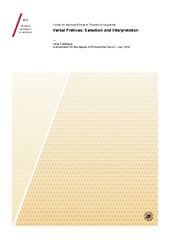| dc.contributor.advisor | Svenonius, Peter | |
| dc.contributor.author | Tolskaya, Inna Konstantinovna | |
| dc.date.accessioned | 2014-10-20T14:05:56Z | |
| dc.date.available | 2014-10-20T14:05:56Z | |
| dc.date.issued | 2014-12-10 | |
| dc.description.abstract | The striking polysemy of Russian verbal prefixes is a well known phenomenon. I show that there is a system to this chaos: prefix meaning is predictable from verbal structure and the prefixation mechanism is similar to that seen in English examples like outdo and overdo.
In my analysis, lexico-syntactic structure plays an important role in explaining the selection and interpretation of prefixes. I uncover a central meaning that remains constant across different uses of a prefix, and describe the formal structural criteria for prefix interpretation in a given context.
A uniform analysis of prefixation is developed, where a prefix relates an event to a scale measuring path, change or time. Both change of state and the development of an activity in time mirror a path in space with beginning, duration and a goal. E.g. a heating event can be seen as a journey along the temperature scale from a colder state to a warmer one. The choice of scale that a prefix combines with is a function of the syntactic position of the prefix, determined by the verbal structure.
This approach is also fruitful for English, where I show that the acceptability of prefixation correlates with a scalarity-based classification of verbs. | en |
| dc.description.doctoraltype | ph.d. | en |
| dc.description.popularabstract | The striking polysemy of verbal prefixes is a nightmare for every student of Russian. I show that there is a system to this chaos, where prefix meaning is predictable from verbal structure and that the prefixation mechanism is similar to English examples like outdo and overdo, where prefixes are not as ubiquitous. In my research I uncovered a central meaning that remains constant across different uses of a prefix, and the formal structural criteria for prefix interpretation in a given context. I demonstrated the correlation of prefix meaning with syntactic properties of the verb it attaches to. My main result is a uniform analysis of prefixes, as relating events to scales, measuring path, change or time. Both change of state and the development of an activity in time, mirror a path in space with beginning, duration and a goal. The choice of scale that the prefix combines with is a function of its syntactic position, which is determined by the verbal structure. This approach also turned out to be fruitful for English, where I explored the possible and impossible prefix-verb combinations and established that the acceptability of prefixation depends on the scalarity-based classification of verbs. | en |
| dc.description | Paper 4 of the thesis is not available in Munin: <p>4. 'Verbal prefixes in Russian: Conceptual structure versus syntax', Journal of Linguistics, volume 51, issue 01, March 2015, pp 213-243, available at <a href=http://dx.doi.org/10.1017/S0022226714000206>http://dx.doi.org/10.1017/S0022226714000206</a>
<p>The accepted manuscript version of paper 4 is available in Munin at <a href=http://hdl.handle.net/10037/6760>http://hdl.handle.net/10037/6760</a> | en |
| dc.identifier.uri | https://hdl.handle.net/10037/6756 | |
| dc.identifier.urn | URN:NBN:no-uit_munin_6356 | |
| dc.language.iso | eng | en |
| dc.publisher | UiT Norges arktiske universitet | en |
| dc.publisher | UiT The Arctic University of Norway | en |
| dc.rights.accessRights | openAccess | |
| dc.rights.holder | Copyright 2014 The Author(s) | |
| dc.rights.uri | https://creativecommons.org/licenses/by-nc-sa/3.0 | en_US |
| dc.rights | Attribution-NonCommercial-ShareAlike 3.0 Unported (CC BY-NC-SA 3.0) | en_US |
| dc.subject | VDP::Humaniora: 000::Språkvitenskapelige fag: 010::Russisk språk: 028 | no |
| dc.subject | VDP::Humanities: 000::Linguistics: 010::Russian language: 028 | en |
| dc.title | Verbal Prefixes: Selection and Interpretation | en |
| dc.type | Doctoral thesis | en |
| dc.type | Doktorgradsavhandling | en |


 English
English norsk
norsk



